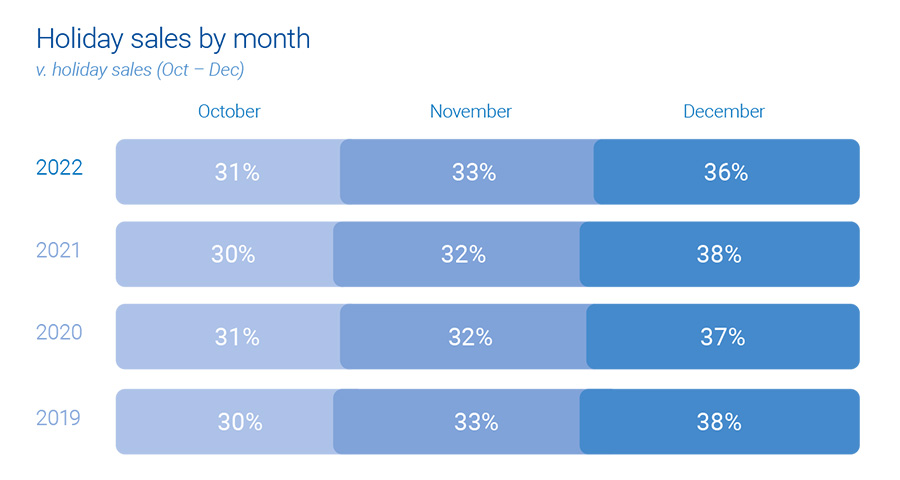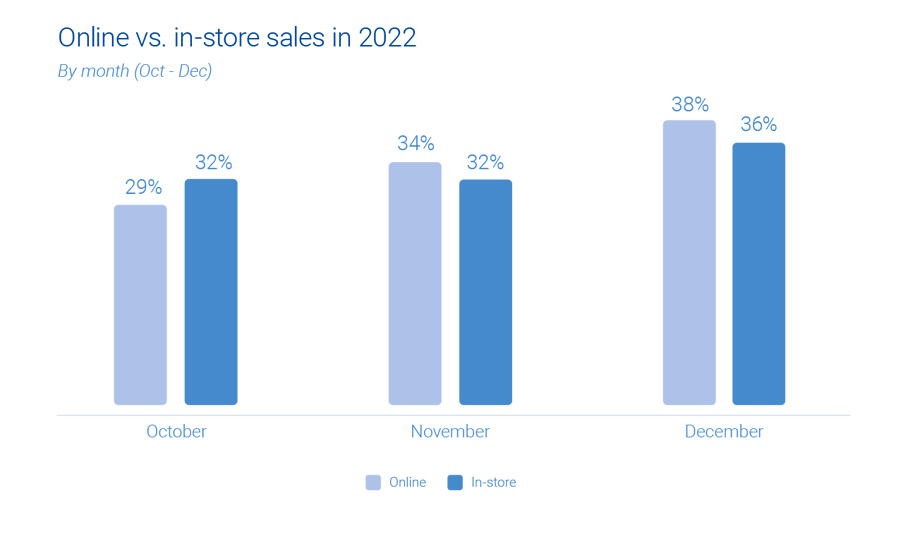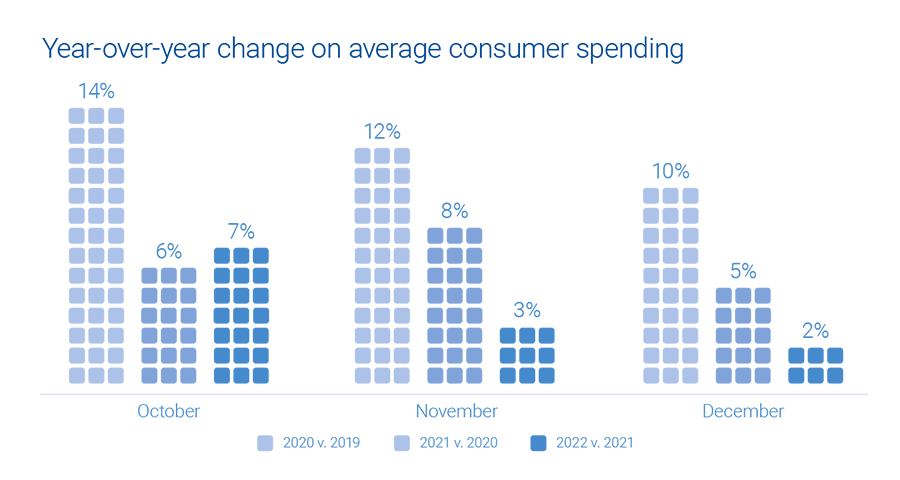
The holiday season is just around the corner, and retailers and marketers are gearing up for the busiest shopping period of the year. It’s crucial to understand how consumer behavior is evolving and what emerging trends to expect. Experian’s 2023 Holiday spending trends and insights report analyzes recent trends, consumer spending habits, and anticipates what’s to come in 2023 to help you deliver a top-notch shopping experience this holiday season.
In this blog post, we’ll cover three key insights from our report.
1. Consumers are shopping earlier
It’s no secret that December has always been the go-to month for consumers when it comes to holiday spending. However, holiday shopping now starts earlier, particularly with online sales.

This can be attributed to a surge in promotions and deals, enticing shoppers to open their wallets ahead of time, giving a significant boost to holiday sales. Notably, Cyber Week sales have proven to be an influential factor, accounting for 8% of total consumer holiday spending.
Experian tip
Reach the right shoppers with your promotions with sell-side targeting. This powerful approach gives you control over where your ads are placed while ensuring maximum visibility through direct connections with publishers. Whether on mobile, web, or CTV, this seamless ad experience will engage your audience effectively.
2. Online sales are on the rise
The popularity of online holiday sales is continuously growing, surpassing in-store shopping. There has been a consistent 1% year-over-year increase in online sales, while in-store sales have seen a 1% decrease.
“It’s easier for consumers to comparison shop for large ticket items online that they might find at a mass retailer or office supply store. Consumers prefer to have larger, bulkier items shipped directly to their home for minimal cost. By shopping online, consumers can save time since they don’t need to wait in checkout lines.”
Anna Liparoto, Sr. Account Executive, Retail & CPG

Although online sales currently make up only one-third of all holiday shopping, there is immense potential for further expansion. Mass retailers and office, electronics, and games industries particularly excel in online holiday sales. While in-store purchases remain the primary choice for holiday shoppers, consumer online and offline activities intersect before the final purchase.
Experian tip
Take advantage of the surge in online shopping by diversifying your marketing channels. An agnostic identity graph can bring together device and media data, capturing valuable user insights. By gaining a holistic view of your target audience, you’ll be able to optimize your ad spend and allocate resources effectively, ultimately boosting your return on investment.
“Omnichannel targeting during the upcoming holiday season will continue to prove to be the best way to reach scale and maximize ROI across all marketing channels.”
Joe LigÉ, Head of Enterprise Demand Partnerships
3. 2023 holiday spending will be on par with 2022
During the holiday season in 2022, consumer spending showed an anticipated increase, although the growth rate was slightly lower compared to previous years. October saw a surge in average consumer spending, indicating a swift response to early discounts and promotions offered by retailers.

As the holiday season progressed, holiday spending gradually slowed down and reached a level similar to that of the previous year. Overall, there was a modest 2% growth. Looking into the future, if economic conditions remain stable in the second half of 2023, we can expect holiday spending to align with the figures from last year.
Experian tip
To truly maximize impact, consider data enrichment. By diving deeper into your target audience’s preferences and behaviors, you can better tailor your strategies and seamlessly integrate the enriched data across various channels. This allows you to unlock the true potential of your ad inventory, creating more meaningful connections with your audience.
Download our 2024 report
Get ready for the holiday shopping season with Experian’s 2024 Holiday spending trends and insights report. Inside you’ll find:
- Analysis of past trends and what they mean for 2024
- Exclusive predictions for the upcoming holiday season
- The top audiences to activate this holiday season
To access to all of our predictions for this year’s holiday shopping season, download our 2024 Holiday spending trends and insights report today.
Latest posts

If you live in an early primary or caucus state, you’ve probably already had your fill of political advertising. According to The Washington Post, politicians and political groups spent more than $23 million on campaign television ads as of December 1, 2011. With record ad spending predicted for the 2012 election, the rest of the nation will soon be bombarded with television ads “approved by” politicians from the left, right and the center of the political spectrum. Candidates and those groups that support them need to know where to allocate their ad dollars to either connect with their base or reach swing voters. Experian Simmons analyzed the viewing audiences of over 600 broadcast, cable and syndicated TV programs that were measured in our most recent National Consumer Study in order to pinpoint opportunities for politicians to reach partisans and middle of the road voters. This analysis has already gathered the attention of major media outlets, including Entertainment Weekly, The Washington Post, AOL, Huffington Post and more. Below are the entertainment and news programs that score the highest concentration of liberal Democrats among their viewers, Conservative Republicans and Middle-of-the-Road Voters registered with any party. Be sure to check out our free 2011 PoliticalPersonas report in which Experian Simmons delivers the mindset of the American voter, including attitudes, brand preferences and their penchant for social media. You can also check out a similar analysis of TV preferences of political partisans that we conducted last year here and here.

Social media continues to be one of the fastest growing industries online. Between September 2010 and September 2011 visits to Social Networks and Forums have increased by nearly 11% and, if you saw my Internet clock blog last month, social media accounts for nearly a quarter of all time spent online. But when are people engaging with social media the most? We took a look at the UK Internet visits to the Social Networks and Forums category each month between 2009 and 2011. We then averaged those visits across the months to see the seasonal trends with social media. What this shows is that social media usage is at its lowest at the beginning of the year and climbs throughout the course of the year towards a peak in December. Over the last three years December has always seen the peak of online visits and in fact last Christmas Day Facebook overtook Google for the first time ever in terms of UK Internet visits. We know that Christmas is a very social time and a time for sharing messages with loved ones, friends and family, so the increased visits to social networks during December is to be expected. More generally, what this graph shows is that social media observes two seasonal trends. The first is an early summer peak in visits in June, before a decline in visits in July and August. This seasonal dip in July and August can be explained by summer holidays where people are more likely to go abroad and therefore less likely to be using social networks. The second seasonal trend is a recovery in visits in September and October before a yearly peak at Christmas. With students starting university terms, kids going back to school, and the working population returning from holiday this would account for the increased interaction in September and October before the Christmas surge. In particular what we’ve seen in September data is a resurgence in market share of visits to Facebook, which bounced back after the summer dip to account for nearly 52% of all visits to a social network. The message here for brands who want to capitalise on social media traffic is to start implementing their social strategy now rather than waiting for Christmas. As October is the second busiest month of the year for social media visits we are expecting over 800 million hours to be spent on social networks this month, which represents a huge opportunity to engage with new and existing customers online. Follow Hitwise UK on Twitter.

Marketing by mobile device is now as popular as ever as retailers send shoppers text messages with special offers and sales. More and more companies are also offering their own phone apps so customers can search for product information and deals on the go. With more than 80 million mobile internet users in the United States, retailers can really benefit from this communication channel. One perk for shoppers is that they no longer have to save and print out coupons from emails! Through their mobile phones, shoppers can receive texts about sales and coupons as they enter stores. They can keep track of their favorite stores and make a purchase anywhere/anytime. One perk for shoppers is that they no longer have to save and print out coupons from emails! All they have to do is show the coupon on their phone at the point of purchase to redeem their coupon. With “QR” bar codes or quick response codes directly on coupons on your phone, savings can be redeemed on the spot. While many people don’t know yet that they can use QR codes on a mobile device, retailers have only begun to take advantage of this technology and more customers are now able to scan items in a store and pay for it using their mobile phones. While it’s just the beginning of a new era, mobile marketing is taking us by storm and now is the perfect time to put this trend into effect.